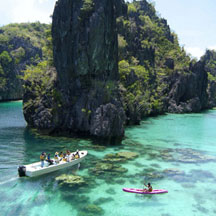Its underground river and Tubbataha Reef, 3 others listed as Ramsar site
PUERTO PRINCESA CITY — The Puerto Princesa Underground River (PPUR) in Palawan has just been officially listed as a wetland of international importance by the Ramsar Convention on Wetlands.

Department of Environment and Natural Resources (DENR) Secretary Ramon J. P. Paje said that the PPUR was the latest site to make it to the list.
Although the designation date of the PPUR as a Ramsar site had been recorded on June 30, 2012, Paje explained that “the annotation of the Philippines’ official list to make it five sites, and the designation of the PPUR as Ramsar Site No. 2084 officially affirms the park as a wetland of international importance.”
This developed as Palawan which boasts of its Underground River, one of the new seven wonders of nature, has been named by Lonely Planet, a well-known travel website, as one of its recommended destinations.
Lonely Planet called Palawan the “ultimate archipelago for adventurers” as it ranked the group of islands 8th in a list of top 10 travel regions for 2013, according to a Yahoo report.
“Palawan incorporates thousands of sparkling, rugged islands and is fringed by 2000km of pristine coastline,” the website said.
It also noted an increasing number of direct flights to Palawan as regional carriers realize the area’s tourism potential.
“So far Palawan’s natural marvels have only been sampled by plucky backpackers. Not for much longer,” Lonely Planet said.
“Throw in the mushrooming growth of style-conscious boutique hotels normally found in places like Ko Samui or Bali, and you can feel that Palawan is ready to hit the big-time in 2013,” it added.
The other four sites in the Philippines are the Agusan Marsh Wildlife Sanctuary in Mindanao; the Naujan Lake National Park in Oriental Mindoro; the Olango Island Wildlife Sanctuary in Cebu; and the Tubbataha Reefs National Park, also in Palawan. Together, all five sites have a total surface area of 154,234 hectares (1,542.34 square kilometers).
Paje had earlier said that the remaining steps in the listing process were the review of the Ramsar Information Sheet and the site map. These are now posted on the Ramsar Sites Information Service website viawww.ramsar.org.
The environment chief added that although there is no monetary prize in becoming an official Ramsar site, “the declaration would entitle the PPUR to possible technical, financial and other forms of assistance on how best to manage the site.”
Information on the Ramsar website describes the 22,202-hectare PPUR National Park as “unique in the biographic region because it connects a range of important ecosystems from the mountain-to-the-sea, including a limestone karst landscape with a complex cave system, mangrove forests, lowland evergreen tropical rainforests, and freshwater swamps.” It also cites the park as home to about 800 plant and 233 animal species, some of which are threatened or endemic.
It cites the 8.2-kilometer long underground river, part of which provides domestic and agricultural water supply to local communities. The underground river had also been recently declared one of the New Seven Wonders of Nature, and is a major ecotourism destination.
Even before its declaration as a wonder of nature and a wetland of international importance, the PPUR National Park had long been declared a National Geological Monument by the National Committee on Geological Sciences. It is also a Biosphere Reserve and World Heritage Site of the United Nations Educational, Scientific and Cultural Organization (UNESCO).
The DENR had nominated the PPUR to the Ramsar Convention in Switzerland in December 2011. The nomination was then presented and defended in the Convention’s Meeting of the Conference of Parties in Romania in July 2012.
The Ramsar Convention is a treaty among 163 countries aimed towards the conservation and wise use of wetlands. To date, it has listed 2,062 wetlands of international importance.



 ShareThis
ShareThis